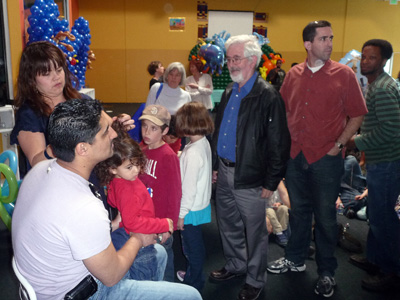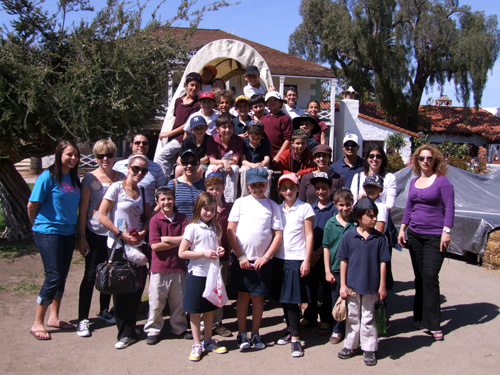
By Donald H. Harrison

SAN DIEGO—My grandson Sky Masori, recently celebrated his third birthday with his first haircut—a Jewish tradition called an “upsherin” that is being revived across the denominational spectrum.
The tradition is based on Leviticus 19:23 in which we are enjoined when coming into a new land not to partake of the fruit on the trees until the third year. By analogy, this commandment is extended to the hair on a boy’s head. We let it grow unharvested until his third birthday.
Although “haircut” is what “upsherin” means in Yiddish, it is not simply a haircut. In fact, it has many different versions, each emphasizing some aspect of Jewish tradition. In Sky’s case, the attention of the guests was directed to a tzedakah container near his chair.
Each person who cut a lock of Sky’s hair was invited to also drop a coin or currency into the container to be used as a donation to Soille San Diego Hebrew Day School, where Sky is a preschool student and where we held the ceremony on Sunday, March 14.
I have read that in other people’s upsherin ceremonies the birthday boy is directed to drop a coin in the tzedakah box each time a lock is cut from his head so as to teach early in his life how important it is to help people who are less fortunate.
Some people also introduce their children to the Hebrew alphabet at this occasion, thereby commencing the process by which the tyke will study Torah. There is a custom to drizzle letters of the Hebrew alphabet with honey so that reading and studying will always be sweet. One can draw an analogy between this custom and eating apples dipped in honey on Rosh Hashanah, the Jewish New Year.
As part of the ceremony, Gerry Burstain, a family friend who distinguished himself as the past president of Ner Tamid Synagogue in Poway, led us in the shehechiyanu prayer, in which we thank God for allowing us to arrive at such a significant moment.
Hair stylist Susie Beyer of Salon Reiki put clips in Sky’s hair to indicate where we amateurs were to make the cuts. I had wondered whether Sky would sit still for such an experience, but for most of the time on the knee of his father, Shahar, Sky had a look of amusement on his face as the ceremony continued. He was not the first in his preschool class to have an upsherin, so he knew exactly what to expect.
Sky’s mother, Sandi, combined the celebration with a secular-style birthday party in which there was a jump house on the playground and a balloon pit inside the school. The owner of Balloon Utopia, Sandi also designed large fanciful balloon sculptures of animals in Sky’s honor. The Zoo, Wild Animal Park and the Visitors Center of Mission Trails Regional Park (where indigenous animals are showcased) are among Sky’s most favorite places to visit.

Two days later, I had the opportunity to lead Sky’s brother, Shor, and 31 other third-grade students of Soille San Diego Hebrew Day School on a historic tour of Old Town San Diego State Historical Park and historic Temple Beth Israel at nearby Heritage Park. The two classes of students were an energetic but respectful group of children, and they paid attention to some of my stories about San Diego’s pioneers.
I was given the honor of teaching the youngsters because I am the author of a history of early San Diego, Louis Rose: San Diego’s First Jewish Settler and Entrepreneur. Victor Walsh, a friend who is California’s official historian at the state park, was kind enough to join us and describe what it was like for students at San Diego’s first school. He also informed us about the current reconstruction of the Casa de Bandini.
The students probably were a little too young for my story about the famous elopement of Henry Fitch and Josefa Carrillo, judging by the way Shor, 8, turns his head away and says ‘yuch’ anytime he sees a man and woman kissing on television. (He doesn’t mind it when Grandma and Grandpa kiss each other, or when his Mommy and Daddy do so, because “you’re family” but as for kisses on television, Shor would much prefer to watch an action cartoon or movie any day).
On the other hand, the girls in the 3rd grade class seemed to find it interesting to learn that Josefa Carrillo was considered the most beautiful woman in all of San Diego during the early 19th century, and that the Mexican Gov. Jose Maria Echeandia was smitten with love for her. But she was not interested in the governor; she loved a Yankee sea captain named Henry Fitch. Josefa and Henry (Enrique in Spanish) decided to marry and actually were in the middle of the ceremony when representatives of the governor (whose headquarters were in San Diego) ordered the wedding halted, saying it was a violation of Mexican law.
Distraught, Josefa whispered to her almost-husband “why don’t you carry me away, Enrique?.” The following night, Pio Pico—a future governor of California—came to the Pear Garden below the Presidio, where Josefa was walking. He had two horses, and together they galloped to San Diego Bay, where Henry awaited her on a ship. They slipped anchor and sailed away to Valparaiso, Chile, where they were married. When Josefa had a baby, she knew when she came home her family would forgive her for the elopement – which they did.
Boys and girls both intently followed the story of the “San Diego Incident” of 1859 during which the Grand Jury interrupted Rosh Hashanah services at the Franklin Hotel in order to subpoena the testimony of Moses Mannasse about a stabbing incident he had witnessed. Moses told the representatives of the jury that as it was a holy day on the Jewish calendar—and furthermore because he was the tenth man at the service, and was needed for it to continue, he could not possibly break away to testify.
But the grand jurors did not want to meet on another day to hear Moses’ testimony, so they sent the sheriff. When Moses refused again, the sheriff deputized a posse, who walked two doors from the court house to the Franklin Hotel, and up the stairs to the meeting room where services were proceeding. Then, despite the protestations of his fellow Jews, they escorted Moses Mannasse out of the services and to the court house.
As the story is told, they sat Moses down in the witness chair and asked him questions about the stabbing. Defiantly, he crossed his arms over his chest and refused to testify – until sundown.
“That’s when Rosh Hashanah was over,” shouted one of the boys, who had been paying close attention.
“That’s right,” I affirmed.
Lewis Franklin, owner of the Franklin Hotel, was a Jew of considerable religious reputation in pioneer California—having hosted the very first High Holiday services in his tent in San Francisco in 1849, having delivered the sermon in San Francisco in 1850, and having hosted the other three Jews in San Diego at his home during High Holidays in 1851–the first known Jewish religious gathering in San Diego.
Franklin indignantly wrote letters to Jewish newspapers around the country describing the incident as highly prejudicial. To hear Franklin tell it, you’d have thought the incident was the worst insult to the Jewish religion since the Romans destroyed the second temple in 70 C.E. Not all the readers of the newspaper agreed, some contending that Moses simply should have given his testimony, with the Rosh Hashanah services recessing to permit him to perform his civic duty.
I told the students that there were debates in Jewish communities around the country, and asked them to tell by a show of hands how they felt about it. There were two students who felt Moses should have testified. All the others believed that Moses was right to insist that the Jewish high holidays be strictly respected.
So for this zeide, it was an enjoyable week of shearing and sharing with students at the Soille San Diego Hebrew Day School.
*
Harrison is editor of San Diego Jewish World